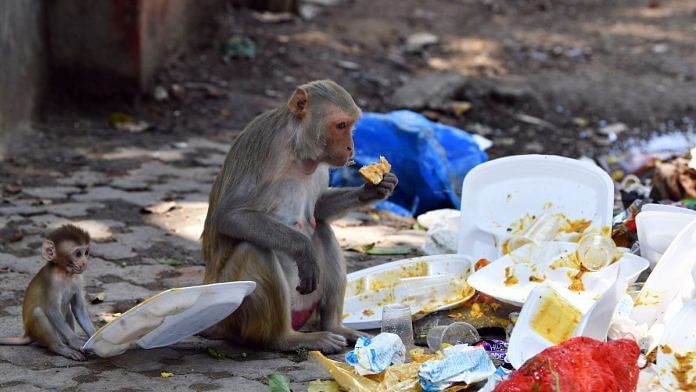Thank you dear subscribers, we are overwhelmed with your response.
Your Turn is a unique section from ThePrint featuring points of view from its subscribers. If you are a subscriber, have a point of view, please send it to us. If not, do subscribe here: https://theprint.in/subscribe/
The year was 1980. I was overcome by a frivolous obsession of adding Dr in front of my name and the only way out I knew was doing a PhD.
A PhD!
But in what?
Zoology.
No way! Never !
And, the reason was my hate for dissections in spite of being a M.Sc. in Zoology and that too a Gold Medallist, 1st class 1st in the University!
Every time when I entered the laboratory if it smelled of formaldehyde, and had some preserved animals that we the students were to dissect I would cringe.
Surely research could be better than long hours in the laboratory in company of mice and toads!
Was there a way out?
Of course, there was.
A doctorate on monkeys in the wild. And I spent the next thirty-five years of my life following monkeys initially by myself later with primatologists from foreign lands, a team of school graduates from around my field area, and university students. It has been exciting but physically exhausting journey and I still do not claim to know everything. Infect I learn from every encounter and every situation.
Years back one day while collecting data in the forest -part of my field area, I heard someone cough. I thought someone with a cold was around. I was wrong. No human was being around. I heard the cough again. One of our subject monkey, named Hari Singh was sitting next to the Bansa (Adhatoda vasica) shrub and eating the leaves.
To know more about Bansa leaves and to understand why monkeys consumed them I started visiting the Central Ayurveda Research Institute. I found that the cough syrup humans have is made from Bansa leaves. Wao! Smart monkeys!
Much later monkeys consuming Bansa leaves were filmed and aired by our national news channel. That evening a man wanted to know if monkeys learnt the use of Bansa leaves from man.
Hmm! Monkeys existed on this planet much before man so of course, primitive man learned it from monkeys. Also, monkeys suffering from cough, and bronchitis visited the solitary amla tree in a remote corner of their habitat regularly when suffering from cough
When I observed Lal Singh, injured in a fight with deep wounds on his head, hands, and back, I started following him. He ate Chirchetta – (Achyranthes aspera) the most followed by Godni (Ixora coccinea). The other plants eaten were Beri(Ziziphus mauritiana ), Kikar( Acacia nilotica), Santhi ka saagh( Amaranthus viridis ), Peepali(Piper longum), Lal phool (Nerium oleander), and Chidiya ki jooth(Corvhorus olitorius). With his wounds completely healed, in four months’ time he was ready to take on his opponents.
Bodhi, a low-ranking female monkey, had wounds on her shoulder as another female had bitten her. She consumed the same diet as Lal Singh.
Monkeys with symptoms of fever like sluggish walking and red eyes ate pods of the Hulhul (Cleome viscosa ) and leaves of Karpuravalli(Coleus amboinicus). For cuts and wounds, monkeys ate buds of Akh (Calotropis gigantea) and applied milky secretion from its branches on their bleeding wounds which helped coagulate blood and stop bleeding.
When they got blisters in their mouths (seen externally as swollen lips) they ate the gum secreted by the Kikar tree and Bitter aloe.
When they got diarrhea Gokhru ( Tribulus terrestris) was consumed. Tender blades and tender white shoots of grass were eaten after vomiting.
Monkeys consumed different kinds of foods during different times of their lives. During the mating period the males ate tubers of Burbunda Barleria prionitis) At the end of the mating period, when around eighty percent of the females would be pregnant, a major part of their diet came from the Imli (Tamarind indica). Its leaves, bark, and fruits were consumed in large quantities. While for the first three months monkey infants depend totally on their mother’s milk [and continued suckling till they were a year old] the lactating mothers ate tender brownish pink leaves of the Peepal(Ficus religiosa) the most.
That research helped me get an insight into the special diet of monkeys in the wild and their understanding of natural herbal medicines.
Afterward, it also helped me understand the behaviour of monkeys in human habitation areas where they suffer due to improper diet and unsuitable habitats.
The monkeys I studied in the wild were lean and graceful. They understood the flora and fauna of their area and ate according to what their body demanded. Fat-free and well-balanced food.
Whereas the monkeys in human habitation areas are generally obese or extremely thin and have dull fur. This was the reason why I objected to people feeding the monkeys processed human foods.
Their wounds of human habitation monkeys don’t seem to heal and their coughs just do not go away.
These pieces are being published as they have been received – they have not been edited/fact-checked by ThePrint


